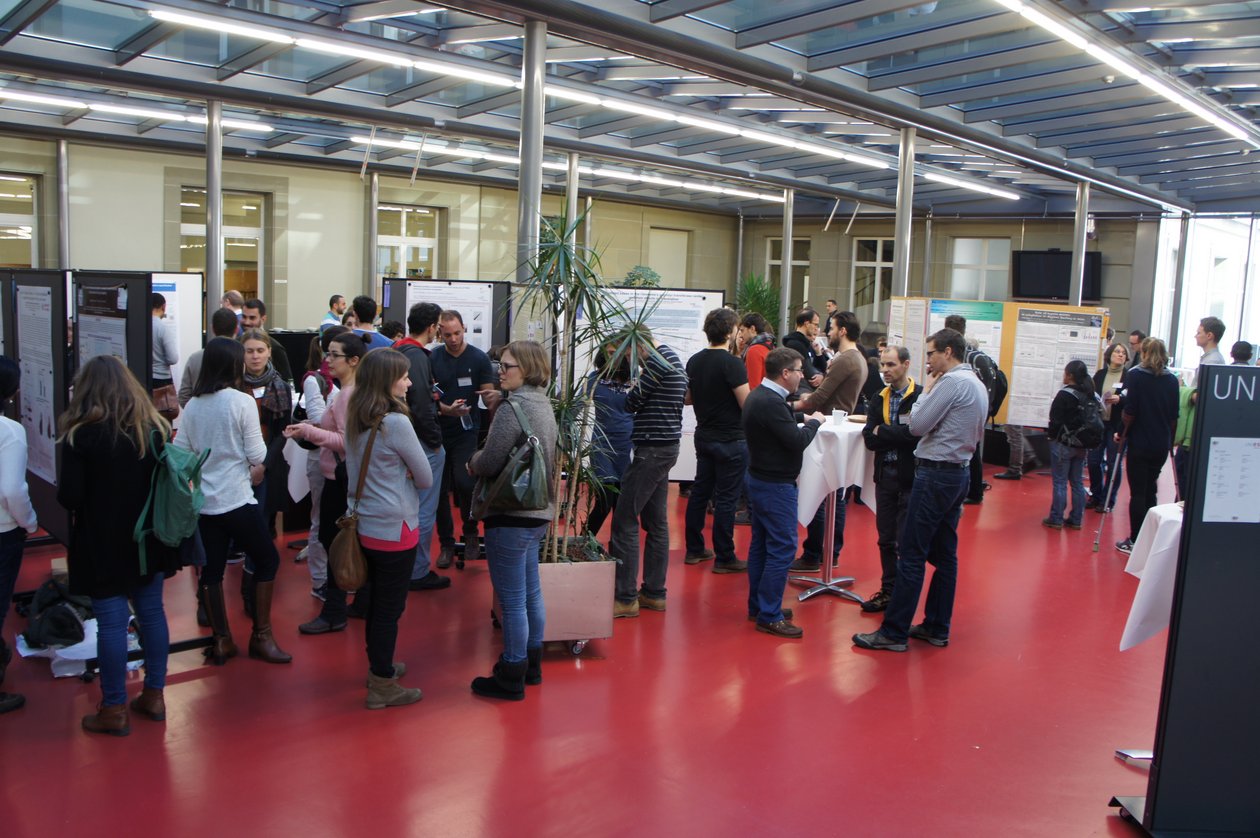Where NCCR scientists inspire each other
At the first annual RNA & Disease Retreat in Kandersteg NCCR scientists reported on their progress made in RNA research.
From January 19 to 21, more than 100 NCCR researchers, including scientists of NCCR laboratories and associate members from more than 30 different Swiss research groups, and invited guests gathered together amidst snow-covered mountains in Kandersteg at the beautiful Belle Epoque Hotel Victoria Ritter. The generous lobby, the plenary and dining hall with their parquet floors, stucco ceilings and chandeliers seemed well-suited to mingle with and learn from other network scientists, and to have exciting talks and lively discussions. Core of the NCCR retreat program were the eight plenary sessions of 15–20 minutes presentations of the progress in projects covering the three NCCR work packages “ncRNA functions”, “RNA metabolism”, and “Translation”. An additional objective at this years’ retreat was to introduce the associate members of the network with a personal presentation of their research.

The event also featured two guest speakers: Nicolas Favre, Head Patents and Licensing at the Friedrich Miescher Institute for Biomedical Research, who gave interesting insights into the do’s and don’ts in intellectual property; and the NCCR SAB (scientific advisory board) member Jørgen Kjems from Aarhus University, Denmark, who talked about the roles of non-coding RNA in brain development and pathology. Generally – and this goes to all presenters – the high quality of the presentations was most striking: the talks were well prepared and the slide shows were visually engaged to capture the audience’s attention. Lively discussions arose among the participants after the talks, and the four SAB members Witold Filipowicz, Jørgen Kjems, Adrian Krainer and Robert J. Schneider, who were present, gave valuable input.

The two poster sessions represented the second core objective of the retreat program and served as another platform for scientific discussions. There, scientists from all fields of the NCCR displayed and discussed their frontline research. The 43 posters presented demonstrated the diverse expertise in RNA research existing in the NCCR network covering the topics of the above-mentioned work packages and broad range of technologies.
Besides the scientific sessions and the intellectual property rights excursion, Ana-Claudia Marques, the new NCCR delegate for equal opportunities as of May 2016 presented the results of the previously conducted survey on equal opportunities within the NCCR Network (results can be accessed here). Based on these results, the participants of the retreat were encouraged to discuss ideas concerning equal opportuni- ties in groups of 5-8 people. The ideas were collected by the NCCR management and will be analyzed and considered for measures to achieve equal opportunities in the NCCR Network.
Leaving Kandersteg in full sun andfresh-fallen snow, most of the attendees did it with their head full of impressions. Some might need time to let the impression settle, others might have already clear ideas where to proceed after being stimulated by the retreat. In a year’s time there will be the next retreat on RNA & Disease. For sure, the majority of this year’s participants are already looking forward to attend again.
The Swiss RNA Workshop
Only one day after the NCCR retreat has ended, the Swiss RNA community held another meeting: The Swiss RNA Workshop. Already for the 17th time, scientsist from all over Switzerland and beyond met in Bern to learn about the newest results in Swiss RNA research. More than 200 researchers participated at this traditional event and attended the thirteen short talks and three keynote lectures held by Maria Carmo-Fonseca, Chris Norbury and Robert J. Schneider and visited the poster session with more than 50 posters.
NCCR Communications

Erythropoietic Protoporphyria (EPP)
One of the projects presented in depth at this years’ retreat concerns a collaboration on Erythropoietic Protoporphyria (EPP) between the groups of Jonathan Hall (ETHZ), Daniel Schümperli (University of Bern) and the new associated group of the Institute of Laboratory Medicine at Triemli Hospital Zürich (headed by Elisabeth I. Minder, Xiaoye Schneider-Yin and Jasmin Barman-Aksözen). EPP is a disorder of heme biosynthesis leaving patients highly sensitive to visible light. The disease arises from a deficiency in ferrochelatase that leads to an accumulation of protoporphyrin IX (PPIX) in the red blood cells and a leakage of PPIX into plasma, skin and bile. Accumulated PPIX absorbs energy from visible light leading to photodamage of the skin causing pain, burning and various other tissue damages. There is currently no cure for EPP. The predominant genotype underlying the disease in 95% of the patients is a splice modulating SNP combined with a loss of function mutation of the ferrochelatase gene. NCCR scientists follow the idea to correct the aberrant splicing and to restore functional levels of ferroche- latase in EPP-patients with two different approaches: the Schümperli group designs bifunctional U7 small nuclear RNAs, while the Hall group synthesizes splice-switching oligonucleotides (SSOs) that target the ferrochelatase pre-mRNA. To become effective, the therapeutic RNA constructs need to be delivered to the bone marrow, taken up by the erythroblasts and finally transported to their nuclei. This is where the Porphyria group of the Triemli Hospital comes into play: their humanized mouse disease model and patient cell lines allow to test delivery, uptake as well as efficacy of the RNA compounds.
By NCCR Communications